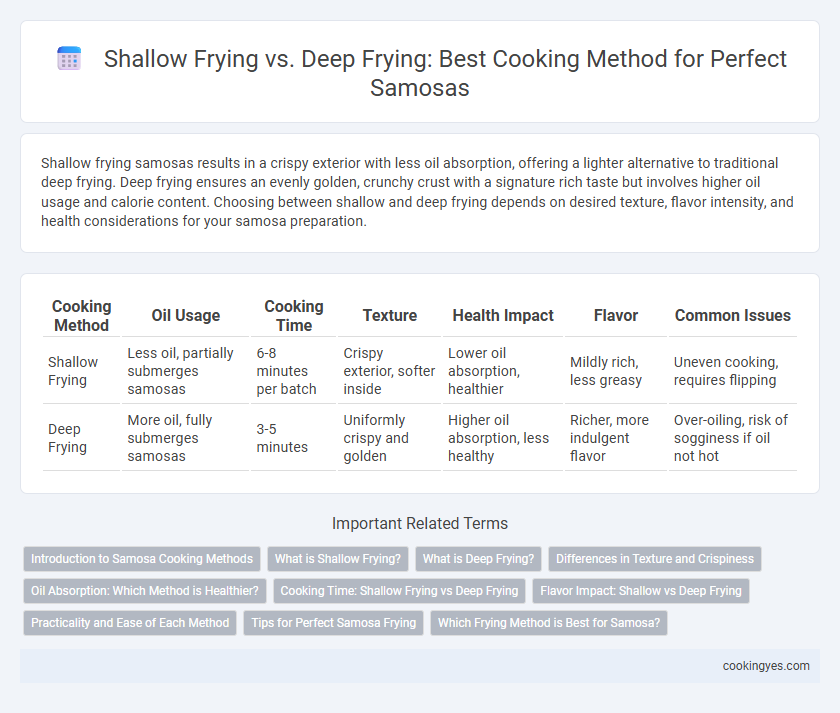Shallow frying samosas results in a crispy exterior with less oil absorption, offering a lighter alternative to traditional deep frying. Deep frying ensures an evenly golden, crunchy crust with a signature rich taste but involves higher oil usage and calorie content. Choosing between shallow and deep frying depends on desired texture, flavor intensity, and health considerations for your samosa preparation.
Table of Comparison
| Cooking Method | Oil Usage | Cooking Time | Texture | Health Impact | Flavor | Common Issues |
|---|---|---|---|---|---|---|
| Shallow Frying | Less oil, partially submerges samosas | 6-8 minutes per batch | Crispy exterior, softer inside | Lower oil absorption, healthier | Mildly rich, less greasy | Uneven cooking, requires flipping |
| Deep Frying | More oil, fully submerges samosas | 3-5 minutes | Uniformly crispy and golden | Higher oil absorption, less healthy | Richer, more indulgent flavor | Over-oiling, risk of sogginess if oil not hot |
Introduction to Samosa Cooking Methods
Shallow frying samosas uses less oil, resulting in a crisp outer layer with a lighter texture, while deep frying submerges the samosas fully, producing an evenly golden and crunchier crust. Shallow frying is often preferred for healthier cooking and easier control over browning, whereas deep frying ensures faster cooking and a robust, traditional samosa flavor. Both methods significantly impact the samosa's texture, oil absorption, and overall taste, influencing the choice depending on dietary preferences and desired finish.
What is Shallow Frying?
Shallow frying involves cooking samosas in a small amount of hot oil, enough to partially submerge the pastry and allow even cooking on all sides. This method uses less oil compared to deep frying, resulting in a lighter texture with a slightly crisp exterior while retaining moisture inside. Shallow frying requires careful temperature control to prevent sogginess and ensure the samosas develop a golden brown, crunchy surface.
What is Deep Frying?
Deep frying involves immersing samosas fully in hot oil at temperatures typically between 350degF and 375degF, resulting in a crispy, golden-brown exterior with an evenly cooked interior. This method uses a larger quantity of oil compared to shallow frying, allowing the samosas to cook quickly and develop a distinct crunch and rich flavor. Deep frying ensures rapid heat transfer, sealing moisture inside the samosa while creating a crunchy texture that is difficult to achieve with shallow frying.
Differences in Texture and Crispiness
Shallow frying samosas results in a slightly softer, less crispy outer layer with a tender interior, as the oil only partially submerges the pastry, allowing controlled cooking and less oil absorption. Deep frying achieves an evenly golden, ultra-crispy texture due to full immersion, creating a crunchier shell and a more distinct separation between the crisp exterior and hot filling. The choice of frying method affects oil content and moisture retention, ultimately influencing the samosa's mouthfeel and overall eating experience.
Oil Absorption: Which Method is Healthier?
Shallow frying samosas uses less oil, resulting in lower oil absorption compared to deep frying, which fully submerges the samosa in hot oil and increases fat content. The reduced oil absorption in shallow frying makes it a healthier option, minimizing calorie intake while retaining crispiness. Choosing quality oil and maintaining proper frying temperature further enhances the health benefits of shallow frying samosas.
Cooking Time: Shallow Frying vs Deep Frying
Shallow frying samosas typically takes 7 to 10 minutes per batch, requiring frequent turning to ensure even browning and thorough cooking. Deep frying samosas cooks them faster, usually within 4 to 6 minutes, as the hot oil surrounds the entire samosa, providing a uniform golden crispiness. The quicker cooking time of deep frying helps lock in the flavors while shallow frying offers a lower oil usage alternative with slightly longer cook times.
Flavor Impact: Shallow vs Deep Frying
Shallow frying samosas results in a slightly less oily texture, preserving the crispness of the pastry while enhancing the natural flavors of the filling due to moderate heat exposure. Deep frying creates a uniformly golden, crunchy exterior with a richer, more indulgent taste as the samosa absorbs more oil, intensifying the savory profile. Flavor impact varies notably, with shallow frying providing a lighter, more balanced taste and deep frying offering a robust, crisp flavor experience.
Practicality and Ease of Each Method
Shallow frying samosas uses less oil and allows for better control over cooking, making it a practical choice for home cooks seeking a crisp texture without excessive greasiness. Deep frying ensures even cooking and a uniformly golden, crunchy exterior but requires more oil and careful temperature monitoring, which can be less convenient in smaller kitchens. Choosing between the two methods depends on balancing ease of use, oil consumption, and desired texture for the perfect samosa experience.
Tips for Perfect Samosa Frying
Shallow frying samosas requires maintaining medium heat and using enough oil to half-submerge each samosa, ensuring even crispiness without excess greasiness. Deep frying demands oil temperature around 350degF (175degC) for uniform golden-brown color and a flaky, crunchy texture. For perfect samosas, avoid overcrowding the pan to prevent temperature drops and drain on paper towels to remove excess oil.
Which Frying Method is Best for Samosa?
Shallow frying samosas results in a crispier outer layer with less oil absorption, making it a healthier option while preserving the traditional texture. Deep frying, however, ensures even cooking and a golden, crunchy exterior but increases oil intake and calorie content. For achieving perfect samosas with balanced crispiness and health benefits, shallow frying is often considered the best method.
Shallow Frying vs Deep Frying for Samosa cooking method Infographic

 cookingyes.com
cookingyes.com